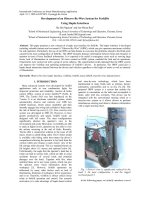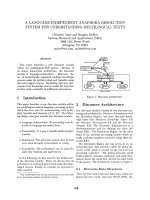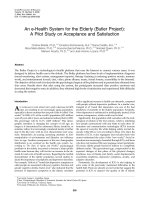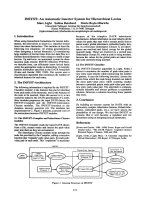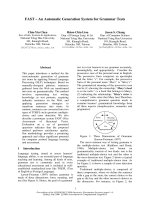- Trang chủ >>
- Mầm non - Tiểu học >>
- Lớp 1
An Effective Recommendation System for ELearning Using Fuzzy Tree
Bạn đang xem bản rút gọn của tài liệu. Xem và tải ngay bản đầy đủ của tài liệu tại đây (295.86 KB, 6 trang )
African Journal of Basic & Applied Sciences 9 (3): 126-131, 2017
ISSN 2079-2034
© IDOSI Publications, 2017
DOI: 10.5829/idosi.ajbas.2017.126.131
An Effective Recommendation System for E-Learning Using Fuzzy Tree
1
1
K. Balaji and 2G. Poorni
Assistant Professor, SNS College of Engineering, Coimbatore, India
2
PG Scholar,SNS College of Engineering, Coimbatore, India
Abstract: The rapid developments of e-learning systems provide learners with large opportunities to access
learning activities through online. However the issues related to e-learning systems reduces the success of its
application. The enormous learning resources that are emerging online make an e-learning system difficult. The
individual learners find it difficult to select optimized activities for their particular requirements, because there
is no personalized system. Recommendation systems that provide a personalized environment for studying can
be used to solve the issues in e-learning system. However, e-learning systems need to handle certain special
requirements. They are learning activities that are often presented in tree structures; learning activities contain
more uncertain categories which additionally contain unclear and uncertain data, there are pedagogical issues,
such as the precedence order for a particular user cannot be given separately for each user. In our proposed
system, a fuzzy tree-structured learning activity model and a learner profile model has been implemented to
improve the performance of e-learning recommendation system.
Key words: E-learning
Fuzzy tree
Knowledge-based recommendation
INTRODUCTION
Recommender systems
used in various web-based applications in e-commerce, ebusiness, e-tourism, e-government, but very few in elearning. Both learning activities and learner profiles have
complex descriptions and features [1].
E-learning systems are becoming popular due to the
development
of
web-based
information
and
communication technologies. The growth of e-learning
systems has changed the traditional learning behaviour of
learners and enhances learning practices online. Due to
the emergence of numerous kinds of learning activities
in the e-learning
environment, learners find it
difficult to select the learning activities that best suit
them. The motivation of this study is to develop a
recommendation approach to support learners in the
selection of the most appropriate learning activities in an
e-learning environment. Recommendation systems, as one
of the most popular applications of personalization
techniques, were first applied in the e-commerce.
Recommendation systems attempt to recommend
items to the users by knowing the interest of the user for
a particular item based on various types of information
such as type of items, usage of items, popularity of items
and the interactions between users and items. The basic
idea of recommendation systems is that similar users like
similar items. Therefore, the similarity measure for users or
items is vital in the application of recommendation
systems. Recommendation systems have been widely
Pedagogical
Resource
Support
Management
E-Learning
Technological
Interface
design
Any time/ place
Fig 1.1: Features of E-learning
A learning activity contains several aspects of
information, such as the content description and so on,
while a learner profile contains the learner’s background,
learning goals, prior knowledge, learner characteristics
and so on. Thus, the data in the e-learning environment
has a hierarchical structure. In reality, learning activities
and learner profiles may contain vague and uncertain
data. One learning activity may be under several
categories with different degrees. The tree-structured
Corresponding Author: K. Balaji, SNS College of Engineering, Coimbatore, India.
126
African J. Basic & Appl. Sci., 9 (3): 126-131, 2017
learning activities and learner profiles are therefore
represented as fuzzy trees. The pedagogical issues must
be considered in the learning activity recommendation.
Some learning activities require prerequisite courses.
For example, studying the subject Data Mining requires
the pre-knowledge about database and algorithms. It is
not feasible to differentiate between two learning
activities just by their names, because learning activities
provided from different sources may have different names
[2].
only once, to potential customers who visited the website
but have not made any purchase and customers who want
to buy a product which is not frequently purchased. It is
hard for collaborative filtering based recommender
systems to accurately compute the neighbourhood and
identify the products to be recommended.
This framework is designed to have four main
components 'getting student information', 'identifying
student requirement', 'learning material matching analyses'
and 'generating recommendation'. In the framework,
information about student requirement can essentially be
obtained in two ways: extensionally and intentionally
expressed. While content-based recommendation and
collaborative recommendation are complementary, it
would further boost the performance by integrating these
two approaches. By using the framework, a learning
recommender system is expected to have the capability to
optimize recommendations and reduce false positive
errors which are learning materials that are recommended,
but the student is not satisfied with them.
Literature Survey
Personal Recommender Systems for Learners in
Lifelong Learning Networks: the Requirements,
Techniques and Model: Model-based techniques
periodically analyze data to cluster them in estimated
models. For instance, ‘genre’ can be a classification of a
movie system and movies of the same ‘genre’ could be
part of one cluster. The average choice of movies from a
specific cluster of movies can then be used to calculate
the interest of a user in a specific movie. Model-based
RSs use techniques such as Bayesian models, neural
networks or latent semantic analysis. The first challenge
in designing an RS is to define the users and purpose of
a specific context or domain in a proper way. These
models require a large corpus (more than 10,000 items) to
estimate their models and provide accurate
recommendations.
Memory-based techniques continuously analyses all
user or item data to calculate recommendations and can be
classified in the following main groups: CF techniques,
Content-Based techniques and hybrid techniques. Userbased CF, Item-based CF, Stereotypes or demographics
CF techniques benefit from the experience of user access.
It allocates learners to groups (based on similar ratings).
Keeps learner informed about learning goal. Attributebased techniques and case-based reasoning is useful for
hybrid Recommendation systems. User-based CF, Itembased CF, Case-based reasoning has no content analysis
[3].
Enhanced Collaborative Filtering to Recommender
Systems of Technology Enhanced Learning: Efficient CF
algorithms that guarantee a multiple assignment of a user
to different clusters, by modifying the FCM objective
function to a Matrix Factorization one. One of the major
problems of RSs is the stability problem of these systems
compared to the dynamic profile of the user. Due to the
two major challenges for the CF based systems like
scalability and scarcity problems, the real time application
of traditional FCM algorithm can confront some
difficulties.
A fuzzy based clustering algorithm is proposed to
regroup learners, including the active learner and that
guarantees a multi-affectation of learners to nearest
clusters allowing them to receive partial recommendations
generated in each cluster according to their membership
degrees. The proposed work alleviates the stability and
plasticity problem and improves the recommendation
accuracy. This technique allows generating learning
resources recommendations to lifelong learners that
correspond to their different interests, tracking their
profile’s evolution [4].
Personalized E-learning Material Recommender System:
Content-based
recommender
systems
provide
recommendations to a customer by automatically
matching his/her preferences with product content.
Collaborative recommender systems estimate a customer's
preferences for a product based on the overlap between
his/her preference ratings for the product and those of
other customers. Content-based recommender systems
cannot be applied to new customers who have purchased
An Effective Recommendation Framework for Personal
Learning Environments Using a Learner Preference
Tree and a GA: Case based reasoning assumes that if a
user likes a certain item, she/he will probably also like
similar items. This approach recommends new but similar
items. Semantic recommender systems, instead of using
127
African J. Basic & Appl. Sci., 9 (3): 126-131, 2017
syntactic matching techniques, use inference techniques
borrowed from the Semantic Web. The performances of
CBR mechanisms are closely related to the case
representation and indexing approach, so their superior
performances are unstable and cannot be guaranteed.
Since more people usually do not spend time to rate
based on each individual criterion in multi-criteria
recommenders.
A new recommendation approach based on the
explicit and implicit attributes of learning resources is
established. Introduction of implicit attributes and
optimization of the weight of these attributes by a genetic
algorithm (GA) to improve the accuracy of
recommendation when the information about explicit
attributes is low. Alleviates the scarcity and cold-start
problems and also generate a more diverse
recommendation list than traditional recommender
systems. In addition, the implicit attribute-based
recommender which uses GAs for the weight optimization
of implicit attributes can increase the accuracy of
recommendations [5].
represented and inferred. The Representation and
reasoning about the behaviour of users and features of
items raise a number of challenging issues. Features of
items and users’ behaviour are subjective, vague and
imprecise. These, in turn, induce uncertainty on
representation of and reasoning about the
items’
features, users’ behaviour and their relationship. The
uncertainty is non-stochastic or non-random and is
induced from subjectivity, vagueness and imprecision in
the data, the domain knowledge and the task under
consideration.
A representational method, aggregation method and
similarity measures for content-based recommender
systems. It also develops algorithms and carries out an
empirical assessment of the effect of fuzzy set theoretic
method on the performance of a movie recommender
system by comparing its results to the results of the
baseline crisp set based method. Handles uncertainty, the
performance is improved and there is a better precision
[7].
Building a Recommender Agent for E-learning Systems:
A log entry is automatically added when a request for a
resource reaches the web server. There exist some
statistical tools that give rudimentary analysis of the web
logs and provide reports on the most popular pages, the
most active visitors in given time periods. The log entries
are not in a format that is usable by mining applications
and requires reformatting and cleansing in order to
identify real session information and path completion. The
ability of the tools to help understand the implicit usage
information and hidden trends in learners’ on-line access
behaviour is very limited.
An approach to build a software agent that uses
data mining techniques such as association rules mining
in order to build a model that represents on-line user
behaviours and uses this model to suggest activities or
shortcuts. This approach can help learners better navigate
the on-line materials by finding relevant resources faster
using the recommended shortcuts. The system assists the
learner to choose pertinent learning material that improves
the performance based on on-line behaviour of successful
learners [8].
A Hybrid Attribute-Based Recommender System for
E-learning Material Recommendation: The existing
recommendation system like content-based system
directly exploits the product’s information and the
collaborative filtering approach utilizes specific user rating
information. The drawback is that it considers only rating
matrix. Moreover Collaborative Filtering approach does
not consider attribute of items and users.
An Attribute-based approach is proposed in
which most frequently visited materials, most similar
visited materials to target learners, most similar
visited to the most similar learner, most frequently
visited to the most similar learner approaches are used.
The learner’s real preferences were satisfied accurately
according to the real-time updated contextual information
[6].
Representation, Similarity Measures and Aggregation
Methods Using Fuzzy Sets for Content-based
Recommender System: Recommendation systems use
historical data consisting of ratings from users before the
recommendation begins input data such as features of
items or users’ ratings in order to initiate a
recommendation and models and algorithms to
combine the former two and generate a recommendation.
A content-based recommendation requires data on the
behaviour of users and features of items. Its performance
depends on the data and how this data is used, i.e.
Existing System: A recommendation approach using
fuzzy tree exists which develops a fuzzy tree-structured
learning activity model for an e-learning system. In the
fuzzy tree-structured learning activity model, a fuzzy
category tree has been defined to specify the categories
that each learning activity roughly belongs to. The
128
African J. Basic & Appl. Sci., 9 (3): 126-131, 2017
precedence relations between learning activities were also
handled through analysing the learning sequences and
modelling the prerequisite learning activities. The
efficiency of the system reduces because of the lack of
groups of learners. By grouping the learners and giving
group recommendations the performance of the system
can be improved.
As a web-based online system, the e-learning
recommender system has a standard multi-tier
architecture, which includes web browser, web server and
database server. The database stores all the data of the
system, which includes the staff data, student data and
subject data. The presentation layer is generates the
requested web pages and handles the user interface logic
and events for the three kinds of users.
Apart from the presentation layer the web server
contains four main parts: the student centre, the teacher
centre,
the
administrator
centre
and
the
recommendation engine. The student centre collects
the user’s profile, tracks the user’s learning behaviour
and provides the recommendations of learning materials.
The recommendation engine generates recommendations
for the student users. Teachers upload the learning
activities in the teacher centre. The administrator centre is
used by administrators to manage the teachers’ data and
subject data. The data access layer deals with the data
operations of the database.
Proposed System
Proposed Recommendation Framework: Implementation
of the e-learning recommender system is designed to have
three types of users: system administrators, teachers and
students. The roles of the users are described as follows.
The role of the system administrator is to maintain the
learning materials and list of staffs, which are used to
support the operation of the system. The teachers are
responsible for managing the learning materials. They
input the learning materials with their descriptions into the
system. They provide their background information when
registering in the system.
Web server
Recommendation
Engine
Teacher Center
Data Access
Presentation Layer
Web Browser
Student
center
Database
Server
Administrator
Fig. 1.2: System Architecture
Preprocess Material Database: The admin of the website
manages the materials in a centralized database. The
admin has privilege to upload, update and delete a
document. Each action should be updated at centralized
database properly. The uploaded material database is
converted into a dataset by preprocessing. The requests
to the website are served by retrieving results directly
from the dataset instead of the database.
cluster according to their membership degrees.The
recommendations given to the groups of learners are more
accurate than the general recommendations.
Content Delivery: The learning materials are
recommended to the learner groups based on their
preferences. These learning materials are recommended
based on the previous searches of the learners in the
group. The recommendation list consists of a set of top
learning materials which were the most preferred materials
by the learners in the same cluster. The final
recommendation varies for every cluster based on the
interest for the learning material by the members of each
cluster.
Grouping the Learners: The learners are grouped into
clusters based on the similarity of their preferences for the
learning materials. Learners with similar preferences are
grouped into a single category. The learners in each
cluster receive partial recommendations generated in each
129
African J. Basic & Appl. Sci., 9 (3): 126-131, 2017
Fig 1.3: Student login page
Fig 1.4: Student search page
Fig 1.5: List of recommended study materials
CONCLUSION
preference leads to improvement in the learning
environment.
Personalized learning is required when e-learning
systems make deliberate efforts to design educational
experiences that fit the needs, goals, talents and interests
of their learners. The proposed personalized e-learning
system takes the dynamic learner’s preferences into
account. The results indicate that placing the learner in an
appropriate teaching style that matches with the learner’s
REFERENCES
1.
130
Dianshuang Wu, Jie Lu and Guangquan Zhang, 2015.
A Fuzzy Tree Matching-based Personalized eLearning Recommender System, IEEE Transactions
on Fuzzy Systems 10.1109/TFUZZ.2426201.
African J. Basic & Appl. Sci., 9 (3): 126-131, 2017
2.
3.
4.
5.
Drachsler, H., H.G.K. Hummel and R. Koper, 2008.
Personal recommender systems for learners in
lifelong learning networks: the requirements,
techniques and model, International Journal of
Learning Technology, 3: 404-423.
Lu, J., 2004. Personalized e-learning material
recommender system, in Proceedings of the 2nd
International Conference on Information Technology
for Application (ICITA 2004), pp: 374-379.
Maatallah, M. and H. Seridi, 2012. Enhanced
collaborative filtering to recommender systems of
technology enhanced learning, in ICWIT 2012,
pp: 129-138.
Salehi Mojtaba, Isa Nakhai Kamalabadi and
Mohammad B. Ghaznavi Ghoushchi, 2013. An
Effective Recommendation Framework for Personal
Learning Environments Using a Learner Preference
Tree and a GA, IEEE Transactions on Learning
Technologies, 6(4).
6.
7.
8.
131
Salehi, M. and I.N. Kamalabadi, 2012. A hybrid
attribute–based recommender system for e–learning
material recommendation, IERI Procedia, 2: 565-570.
Zenebe and A.F. Norcio, 2009. Representation,
similarity measures and aggregation methods using
fuzzy sets for content-based recommender systems,
Fuzzy Sets and Systems, 160: 76-94.
Zaiane, O.R., 2002. Building a recommender agent for
e-learning systems, in Proceedings of 2002
International Conference on Computers in Education,
pp: 55-59.

